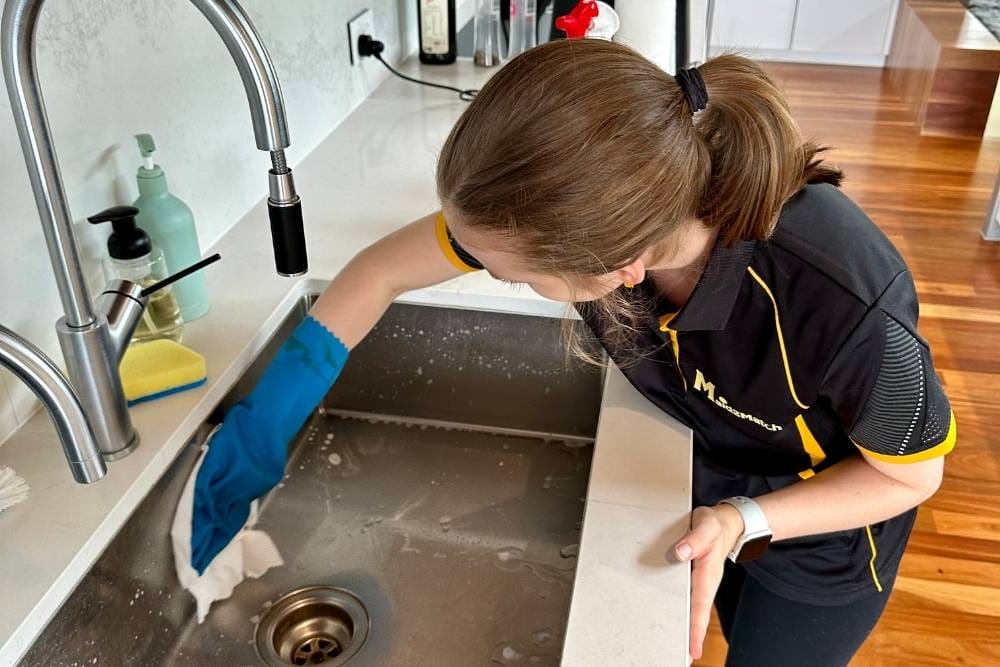Much like the shower, we’re sure most of us would love it if sinks cleaned themselves. After all, we’re already washing things in them with soap and water!
But every part of your house needs cleaning, and that goes double for anything in the kitchen — including the sink.
Leftover food scraps, sauces, soap residue, and other debris accumulate on those surfaces every day. To stay ahead of all that dirt, be sure to wash the sink after the last load of dishes.
How you clean a kitchen sink will depend on the material. For everyday cleaning, hot water and dish soap are more than enough — then choose a tougher solution for deep cleaning or removing stains.
A clean sink helps maintain overall kitchen hygiene! So roll up those sleeves and get ready to get wet.
What to Clean With | Deep Cleaning the Sink | Cleaning the Faucet | Cleaning the Drain | Disinfecting the Sink and Drain | Removing Stains | Unclogging the Drain
How Often to Clean the Kitchen Sink
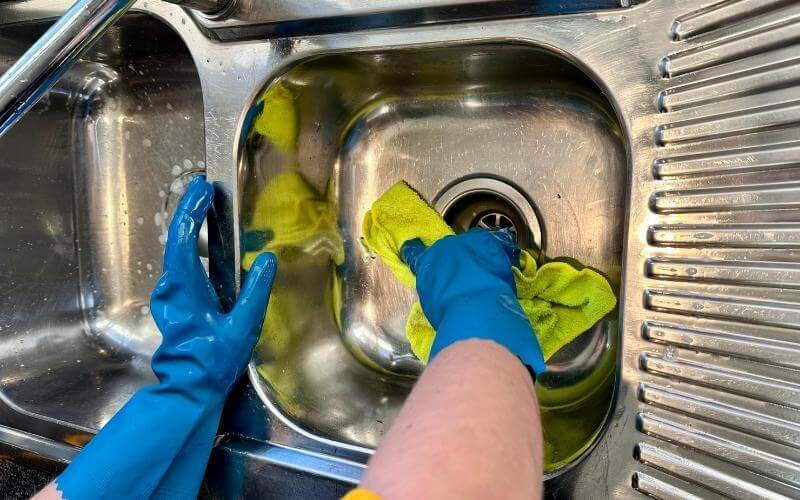
Wash your kitchen sink at the end of each day, when you’re done cooking food and washing dishes! Then dry it thoroughly afterwards so you don’t leave water spots.
If you handled raw meat or acidic foods, wash the sink with hot water and soap immediately. Disinfect the sink afterwards.
Deep clean the kitchen sink and drain once a week. Make them part of your kitchen cleaning routine!
What to Clean the Kitchen Sink With?
The best and easiest way to clean a kitchen sink is with hot water and dish soap. It’s great for everyday washing-up and works on all kinds of sinks.
For deep cleaning, we’ve rounded up our recommended kitchen sink cleaners for each type of material:
- Aluminium: Soapy water or powder cleanser
- Ceramic or porcelain: White vinegar and dish soap
- Granite: pH-neutral soap or stone cleaner
- Stainless steel: Baking soda and dish soap
Copper sinks aren’t as common, but you can wash them with warm water and mild dish soap.
If you want to treat yourself to a full kitchen clean — from the sink to the floor — leave the work to pro home cleaners.
Deep Cleaning the Kitchen Sink (By Type!)

Before cleaning the kitchen sink, take out any dirty dishes and cutlery! For large food bits, remove them with a paper towel so they don’t accidentally clog the drain.
Quickly pre-rinse the sink to wash away any crumbs and other food debris. Skip the drying — you want the sink damp when you clean it.
Wear rubber gloves and open the windows so you’re working in a well-ventilated space.
Avoid harsh chemicals (like bleach) or highly abrasive cleaners, which can damage your sink.
How to clean an aluminium sink
Aluminium can scuff easily (compared to stainless steel), so it needs a bit more care when cleaning.
Do not use baking soda to clean aluminium as it can cause oxidation and discolouration. Avoid acidic cleaners as well.
For routine cleaning, just give your aluminium sink a good wash with some dish soap and warm water. Use a non-abrasive sponge to scrub the surfaces.
If you want a deeper clean, look for an aluminium-safe powder cleanser like Bar Keepers Friend Cleanser! Sprinkle the product onto the wet sink, then scrub the surfaces clean with a wet cloth or sponge.
Rinse the product off, then wipe the sink dry with a clean cloth. Follow the grain of the metal and avoid wiping in a circular motion, which could cause smudges and streaks.
How to clean a ceramic or porcelain sink
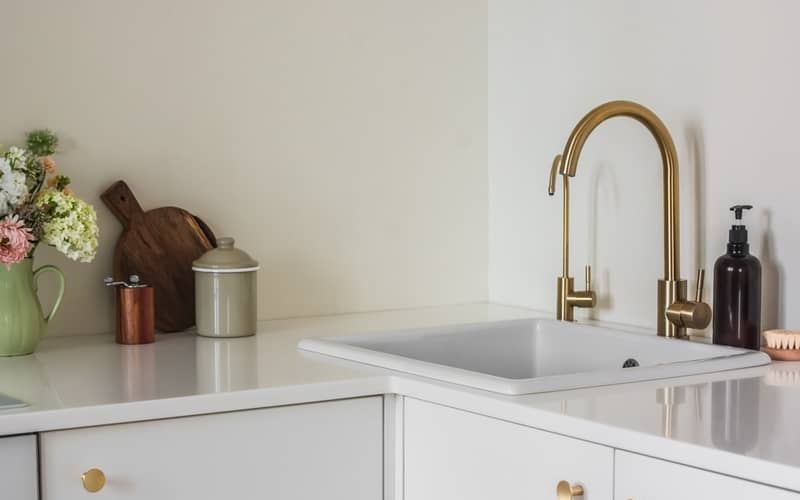
Both ceramic and porcelain are pretty forgiving materials, so you can use mildly acidic cleaners like vinegar or lemon juice.
To clean a ceramic or porcelain sink, pour equal parts white vinegar and warm water into a bowl. It’s optional, but you can add a few drops of pH-neutral dish soap.
Dip a non-abrasive sponge into the solution and thoroughly scrub your kitchen sink. For stubborn dirt, use a soft-bristled scrubbing brush.
Rinse the whole sink afterwards, then wipe it dry.
How to clean a granite sink
These are also called granite composite sinks, since they’re built with a mix of granite, quartz, and resin.
The composite makes the sink more durable and less porous, so it’s easier to maintain! Just avoid using acidic cleaners that could scratch or remove the sealed finish.
When cleaning a granite kitchen sink, the easiest method is warm water and a neutral soap. (Mild dish soap works, too.) Carefully scrub the surfaces clean with a non-abrasive sponge.
For a deeper clean, look for a dedicated stone cleaner, like Weiman Granite and Stone Clean & Shine or Granite Gold Daily Cleaner. Follow the product instructions and rinse the sink afterwards if necessary.
Check with your granite sink’s manufacturer about how often you need to re-seal the sink. Maintaining the sealed finish prevents stains and keeps out moisture.
How to clean a stainless steel sink
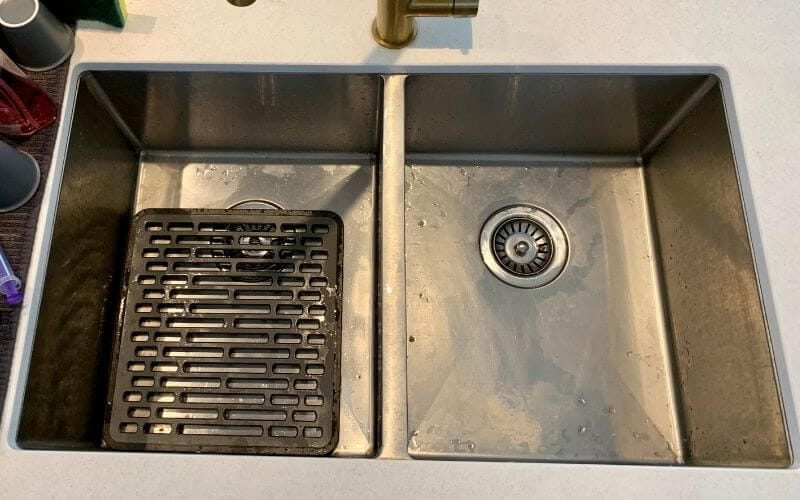
Cleaning stainless steel is pretty straightforward — even for the sink! The material is very durable and easy to maintain.
Avoid acidic cleaners, as prolonged exposure can damage the finish and lead to rust spots.
To deep clean a stainless steel kitchen sink, sprinkle a light layer of baking soda onto the damp surfaces. You don’t need to coat all the surfaces, or the excess baking soda could clog the drain when washed off.
Separately, mix a few drops of dish soap into some hot water. Dip a sponge into the cleaning solution, then use it to scrub the sink clean.
Go with the grain so you don’t scuff the finish, and push any residue towards the drain. Add more soapy water as necessary until the sink is clean.
Rinse the sink thoroughly and immediately dry with a microfiber cloth — stainless steel is prone to hard water spots!
NOTE: You can also use a dedicated stainless steel product, such as Koala Eco’s Stainless Cleaner. Follow the product instructions and skip the dish soap.
Cleaning a Kitchen Faucet
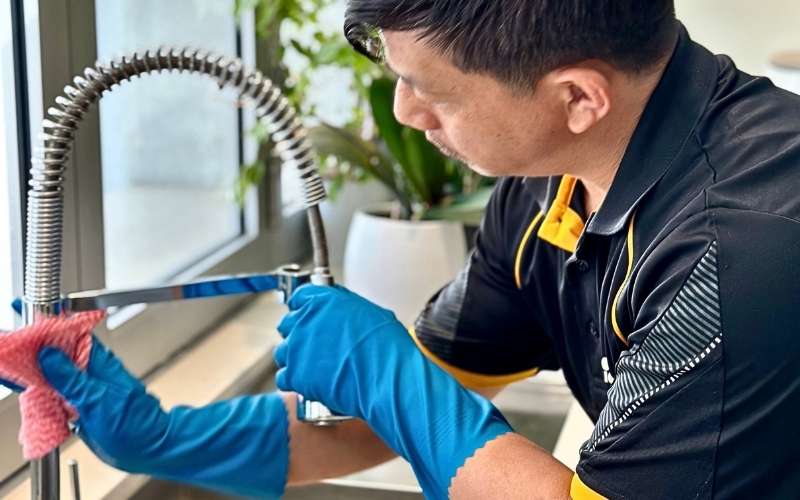
Don’t forget the kitchen faucet and handles! You can wash them with a mix of equal parts vinegar and water, or plain dish soap and water.
Use an old toothbrush or soft-bristled scrubbing brush to scrub any edges and hard-to-reach spots.
If the faucet has hard water deposits, you can use the same cleaning technique for your shower head.
Fill a small, reusable plastic bag with some white vinegar. Place it over the faucet head so it’s submerged, then secure it with some rubber bands.
Leave the bag for a few hours. After taking it off, scrub the nozzles with an old toothbrush and some dish soap.
Run the hot water tap for a minute to flush out any debris. Rinse the rest of the faucet, then dry it with a microfiber cloth.
Cleaning the Kitchen Sink Drain
Food debris, soap scum, and other unpleasant things accumulate in the sink drain over time. If you don’t regularly clean the drain, the build-up can cause clogs and nasty odours.
Trapped food and dirt can even lead to mould and bacteria growth.
To clean a kitchen sink drain, boil a kettle full of equal parts white vinegar and water. Slowly pour the hot vinegar-water solution down the drain in a swirling motion (be careful!).
The heat will dissolve any build-up in the drain, while the vinegar can help cut through grease and remove odours.
Wait a few minutes, then wash the drain with dish soap and water. Use an old toothbrush or soft-bristled brush to get into any crevices.
If your kitchen sink drain has a removable sink strainer or drain sieve, take it out and soak it in hot, soapy water for 10 minutes. Scrub it clean, then rinse and dry the strainer before placing it back.
NOTE: Avoid using baking soda with vinegar when cleaning the drain! Combining baking soda and vinegar makes them less effective when cleaning, and the carbon dioxide may get trapped in your pipes.
How to Disinfect Your Kitchen Sink and Drain
If you’ve handled raw meat, poultry, or fish, it’s best to disinfect your kitchen sink afterwards. This removes any bacteria like salmonella, which could contaminate other surfaces in your kitchen.
Start by rinsing your sink and drain thoroughly in hot water. You want to remove any debris or food particles so the entire surface is exposed.
For aluminium and stainless steel sinks, spray the sink down with 70% isopropyl alcohol. Leave the alcohol to evaporate from the surface (at least 5 minutes), then do a final rinse.
For granite, porcelain, or ceramic sinks, you can use 3% hydrogen peroxide. Apply the peroxide with a spray bottle or a soft cloth, then let it sit for at least 5 minutes to fully sanitise the surface.
Wash the sink with soap and water afterwards.
To disinfect the kitchen sink drain, carefully pour a cup of 3% hydrogen peroxide down the opening.
If you have metal pipes or a stainless steel sink drain, opt for a commercial sanitiser.
Removing Stains from Your Kitchen Sink

Leftover food, drinks, and sauces can leave stains on your sink, especially when not cleaned right away.
If soap and water don’t get the stain off, you’ll need to break out a stronger cleaning method and some elbow grease.
Using baking soda
This stain removal method works on most types of sinks except aluminium.
Mix baking soda (or corn flour) with a little warm water to form a thick paste. Apply the paste to the stained spot on your sink, then let it sit for at least 20 minutes.
Gently scrub the stain off with a damp sponge or microfiber cloth. Rinse the residue down the drain, then dry your sink with a clean cloth.
For very stubborn stains, leave the paste to sit overnight.
Using borax
A small amount of borax is safe for removing stains on aluminium sinks. Do not mix it with anything else except water!
Lightly wet the stained spot on the sink, then sprinkle a teaspoon of borax onto the surface. Gently scrub the stain clean with a non-abrasive sponge dipped in hot water.
Once the stain is gone, rinse the sink and wash it with soap and water.
Using hydrogen peroxide
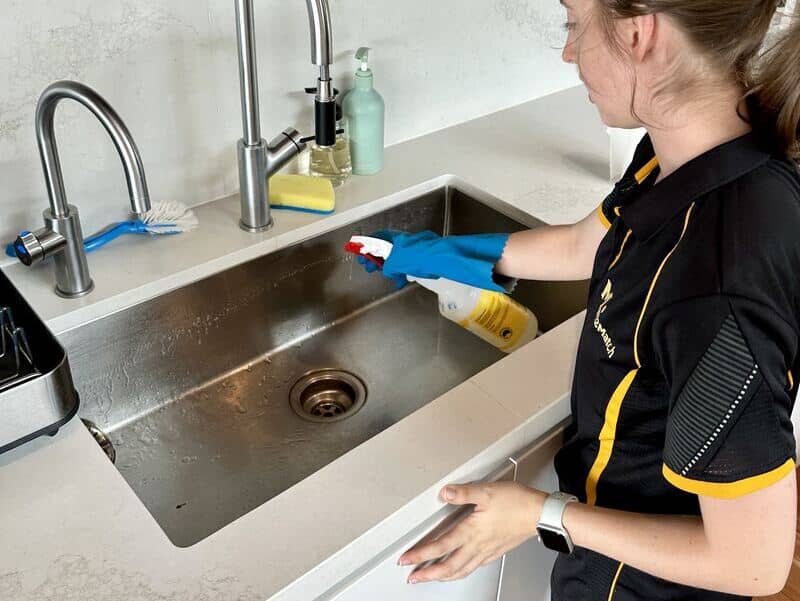
Hydrogen peroxide is effective at removing stains on granite, ceramic, and porcelain!
However, do not use it on an aluminium or stainless steel sink, as it can cause corrosion or pitting.
Sprinkle baking soda onto the stain, then spray a little 3% hydrogen peroxide over the surface. Let it sit for a few minutes before wiping off the residue with a damp cloth.
Wash the sink with soapy water afterwards.
How to Unblock the Sink Drain
Sometimes, the food scraps and soap build up enough to cause a blockage in the drain.
If your sink is draining too slowly or the water is backing up, the drain is likely clogged. You’ll need to unblock the drain ASAP.
For those living in a rental, contact your landlord or property management. They may have a designated plumber to handle the job.
Using boiling water
Sometimes, good ol’ hot water will do the trick! Boil a kettle of water and slowly pour it down the drain, pausing every so often to let the water melt any blockages.
Keep going until the water flows down the drain without obstruction.
Avoid using this method for PVC pipes that are not rated for high temperatures. You could cause the pipes to warp or melt, leading to further damage.
Using an enzyme cleaner
Look for an enzyme-based drain cleaner that’s safe to use on your plumbing! The enzymes will break down organic matter, including food.
Wear protective gear and open the windows so you’re working in a well-ventilated room. Follow the product’s instructions and do not mix the cleaner with any other substance.
Using a sink plunger
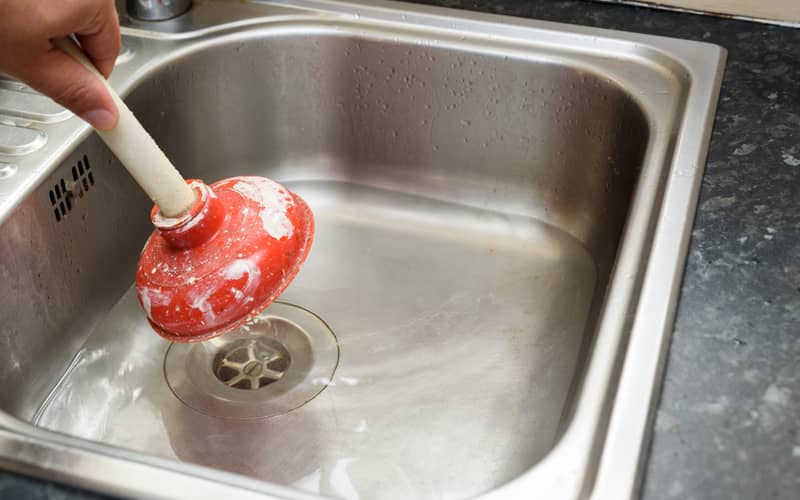
This method can be a bit tricky! Incorrect use of the plunger can force the blockage further into your drain instead of getting it out.
Line up the sink plunger so it covers the entire drain. Press down slowly — so you don’t push the clog down — and then quickly pull the plunger back up.
This way, the suction pulls the clog up towards the mouth of the drain. Then you can either break up the clog or remove it from the drain entirely.
Using a drain snake
If you have a drain snake or auger, you can use it to try and break up the blockage inside the drain.
Carefully feed the end of the drain snake into the opening. Keep going until you feel the tip hit the blockage.
The next step depends on how your drain snake works. Some models allow you to twist and turn the tip so it breaks up the clog, allowing it to flow down the pipes.
Other models latch onto the clogged material and retract, pulling the clog out of the drain.
Once you’ve gotten the blockage out, flush the drain with a kettle or two of boiling water to remove any remaining debris.
Sink Savvy: Kitchen Sink Cleaning Tips
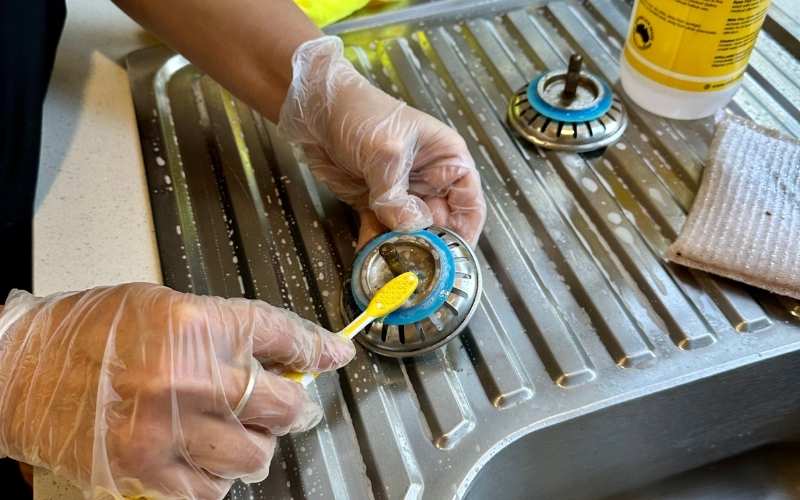
Don’t let dirty dishes pile up in your sink! They can contribute to food debris and odour build-up, and make things harder to clean later on.
If you don’t have time for a more thorough clean, disinfect your sink with some rubbing alcohol or a commercial spray. You can also look for disinfectant wipes.
For kitchens with insinkerators (or garbage disposals), don’t let food sit for prolonged periods! Run the disposal frequently and remove any odours by throwing in some citrus rinds.
Thoroughly dry the sink after washing the dishes. This helps prevent water spots, especially if you live in a hard water area.
And of course, be careful what you wash down the drain. Things like rice (dry or cooked), egg shells, and large amounts of flour or grease can easily clog your sink — and that’s more inconvenient than tossing them in the rubbish!

